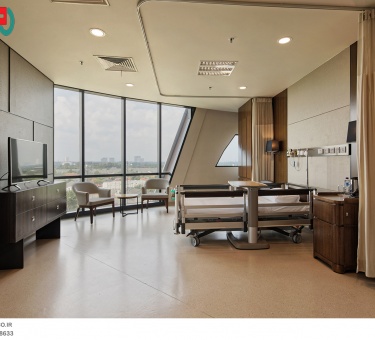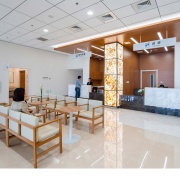A key determinant of everything that matters when it comes to health interventions — the experience, cost, and results — has been hiding in plain sight. It is the buildings and spaces in which patients are treated. The size and layout of a room, whether a bed sits in the middle or against a wall (even which wall), how much space is maintained for patients to walk versus how many beds or operating equipment can be accommodated, have not been considered predictors of health outcomes in the past. That’s changing, as architects and health care organizations come together to incorporate principles of social design into the built health care environment.
“Social design,” a term whose roots go back several decades, fully entered the lexicon around 2006. It refers to the design of relationships, including those that are invisible and intangible. Unlike design thinking, an iterative process for developing alternative ideas and strategies based on understanding a “user” and a specific problem, social design addresses the needs of whole communities or societies. In health care that means reimagining the role a building can play in the health of its inhabitants and the locale in which it is situated.
Consider the collaboration between Dr. Neel Shah and nonprofit architecture firm MASS Design Group. Shah, assistant professor of obstetrics, gynecology, and reproductive biology at Harvard Medical School, directs the Delivery Decisions Initiative at Ariadne Labs, a partnership between the Brigham and Women’s Hospital and Harvard’s T.H. Chan School of Public Health. Cofounded by Michael Murphy, a Harvard-trained architect who has devoted himself to improving the social impact of built environments, MASS is changing the way hospitals are designed and constructed. Murphy has written extensively about the offenses his profession commits against the vulnerable and powerless, especially with hospitals, prisons, and public housing.
In 2014, Murphy made a presentation on the history of hospital design at Ariadne Labs. His observations about the impact of hospital design on patient health and dignity struck a chord with Shah. For the next year, Shah and a MASS research team — led by Murphy, Amie Shao, and nurse-turned-architect Deb Rosenberg — embarked on a study of the growing crisis in unnecessary Caesarean deliveries in the United States, which result in hundreds of thousands of cases of avoidable suffering due to surgical complications and lead to $5 billion in wasted spending each year. They looked at 12 diverse facilities for evidence of how unit design affects Caesarean rates. (Previous studies looked only at room scale, not unit scale.) They found, among other things, that hospitals with relatively more operating rooms and relatively fewer labor rooms tended to do more surgery.
But the story is much bigger than one narrow area of clinical care. In other work, MASS has demonstrated that every aspect of the design of hospitals and clinics is an opportunity to improve patient experience and outcomes. The Butaro District Hospital in Rwanda has become a benchmark for how prioritizing patients’ health can prevent the spread of infectious disease and send patients home faster. Working with Paul Farmer’s Partners in Health, MASS helped design the hospital to mitigate and reduce the transmission of airborne disease through overall layout, patient and staff flow, and natural cross-ventilation. The use of local materials — like volcanic rock from the Virunga mountain chain — and local labor-intensive practices enabled a site-appropriate, sustainable design and stimulated the local economy.
The Cholera Treatment Center in Haiti, developed in partnership with Haitian health care provider Les Centres GHESKIO, incorporates a wastewater-treatment system designed to prevent recontamination of the water table, stopping the spread of disease. Local metalworkers crafted the facility’s façade; local craftsmen helped produce furniture tailored to the needs of cholera patients.
In the work of MASS and in the insights emerging from the research initiative on clinical care in childbirth a number of key social design principles can be seen — principles that are adaptable to any built environment in which health care is delivered. Those principles include the following:
Make sure your vision reflects the ultimate objectives. Shah set out to examine whether health care facilities are designed to deliver, as he says, more health or just more health care. For example, hospitals have traditionally measured their success in terms of bed occupancy. Consequently, their design features many private rooms and little space for walking. But current medical thinking holds that for a great many patients and conditions, getting up and around is essential for recovery. The traditional hospitals are delivering health care, but not necessarily health, which should be the ultimate objective.
Seek input from people who don’t think like you. Patients, families, physicians, nurses, administrators, and architects look at issues through different lenses. They are all important to understanding why things happen the way they do. For example, various stakeholders in the Butaro District Hospital asked why a hospital ward should follow traditional layouts, with patients lying with their heads at the exterior wall while doctors and visitors have views out the windows behind them. What happens when sick people have a view of the countryside instead of staring at other sick people all day long? Why employ traditional designs for ventilation when they depend on a power grid that often fails, exposing patients to airborne diseases that make them sicker than they were when they entered the hospital?
Make the invisible visible. Make maps and draw the systems at work in your facility, including patterns of traffic, people who talk to each other and those who don’t, and room and building layouts. Drawing is the only reliable way to make sure diverse people are seeing the same thing. Shifting the language we use from verbal to visual uncovers the hidden dynamics that form our thinking and behavior and unleashes new thinking. An architect’s instinct to measure size and traffic flow in labor units helped make the causes of the C-section epidemic visible.
Experiment continually. Planning, especially facilities planning, almost inevitably stifles ongoing innovation. Planning builds in assumptions about the future at a time when things change faster than ever — in health care no less than in other areas of our lives. It freezes design — of processes as well as space — in place. And it often puts an end to transformation until the next distant planning cycle. Counterbalance long-term planning through constant experimentation that proceeds on the belief that complex problems can be unraveled and innovation hastened by really listening to feedback gleaned from prototypes that keep designers’ work connected to the needs of the communities they serve. This model is emerging in interdisciplinary innovation labs like the Helix Centre at Imperial College London, the Center for Innovation at the Mayo Clinic, and the Consortium for Medical Technologies at Massachusetts General Hospital, where clinicians, designers, engineers, patients, and business professionals engage in continual innovation.
Adoption of these principles of social design can not only help lead to better health outcomes but also help hospitals thrive at a time when patients increasingly seek information to guide their choice of health care facilities. Those decisions often include elements of design, though consumers may not frame them that way, thinking instead in more concrete terms like whether a facility has dedicated walking spaces to help speed convalescence and shorten hospital stays or waiting areas that don’t feel like bus stations. And some consumers will include in their deliberations larger social goods like the facility’s relations with its neighborhood and its reputation for delivering health, not just health care.
Reference: https://hbr.org/2018/10/how-the-architecture-of-hospitals-affects-health-outcomes





